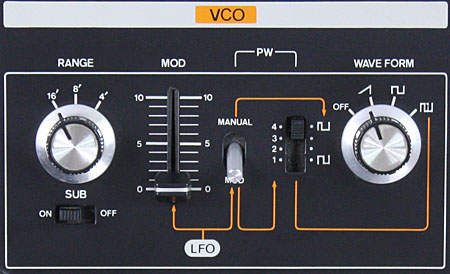AM8400DemoMovie Published on Mar 11, 2018 AMSynths
"Quick demo of the various wave shapes from my Jupiter VCO clone, note the sawtooth waveform, is composed of curved steps."
 via AMSynths:
via AMSynths:"This is replica of the VCO in the Roland Jupiter 4, their first polyphonic synthesizer introduced in 1978. The original VCO is a unique design based around a 555 timer and a CMOS divider chip, which was not seen in any other synthesizer. The Jupiter 4 is famous for its powerful sounds and efficient controls. The constraints of microprocessors in 1978 mean there were only 16 sliders that could be memorised, which limited the functionality of the VCO to 4 octave range and 3 waveforms.
This VCO is the sound of early Human League and Depeche Mode albums.
Detailed Description
The AMSynths circuit is very close to the original except for a new Tempco based matched transistor pair rather than the obsolete heated uA726 chip, as the exponential generator and variable slider controlled Pulse Width rather than a 4-way switch.
The waveform shapes are created from the 555 timer which generates square waves that are divided down for the lower ranges. These square waves are used for the square wave output and are perfect and stable 50/50%. They are also approximated into a sawtooth which has as many steps as the range (16′ has 16 steps, 2′ has just 2 steps). The sawtooth wave is therefore not perfect and is made up of steps, this creates a different sonic shape as you change octave. The pulse width wave is created from the sawtooth rather than the square wave, and therefore has some variability in width, rather than being totally stable. Adjusting pulse width is effectively quantised by the sawtooth steps and jumps from one setting to the next rather than being smooth.
Jupiter 4 Sawtooth
The sawtooth and pulse width waves are quite different to any other synthesizer and contribute a lot to the unique Jupiter 4 sounds, and contain more harmonics and movement. It also appears to be a stable design which used with a modern expo generator.
Original components have been used, along with a few careful upgrades:
Original DN819 CMOS divider chip
Modern 1% Polystyrene Capacitors
LS312 Matched Transistor Pair
Precision 5V and 10V reference voltages
The panel design keeps close to the original with a rather sparse set of controls. Frequency range on a rotary switch from 2′ to 16′, a choice of three waveforms (off, sawtooth, square, pulse), a frequency modulation slider, a Pitch rotary potentiometer, a pulse width selection switch (manual/external), a slider for modulation amount and a sub oscillator on/off switch. The VCO can be used standalone, or in pairs like the ProMars using the Doepfer bus as the controlled keyboard CV, or four VCO’s can be used with a MIDI to polyphonic converter for the full Jupiter 4 sound.
There are just three 3.5 mm jack sockets on the base of the front panel:
Frequency Modulation Input
Pulse Width Modulation input
Audio Output"












































No comments:
Post a Comment
To reduce spam, comments for posts older than one week are not displayed until approved, usually same day. Do not insult people. For items for sale, do not ask if it is still available. Check the auction link and search for the item. Auctions are from various sellers and expire over time. Posts remain for the pics and historical purposes. This site is meant to be a daily snapshot of some of what was out there in the world of synths.